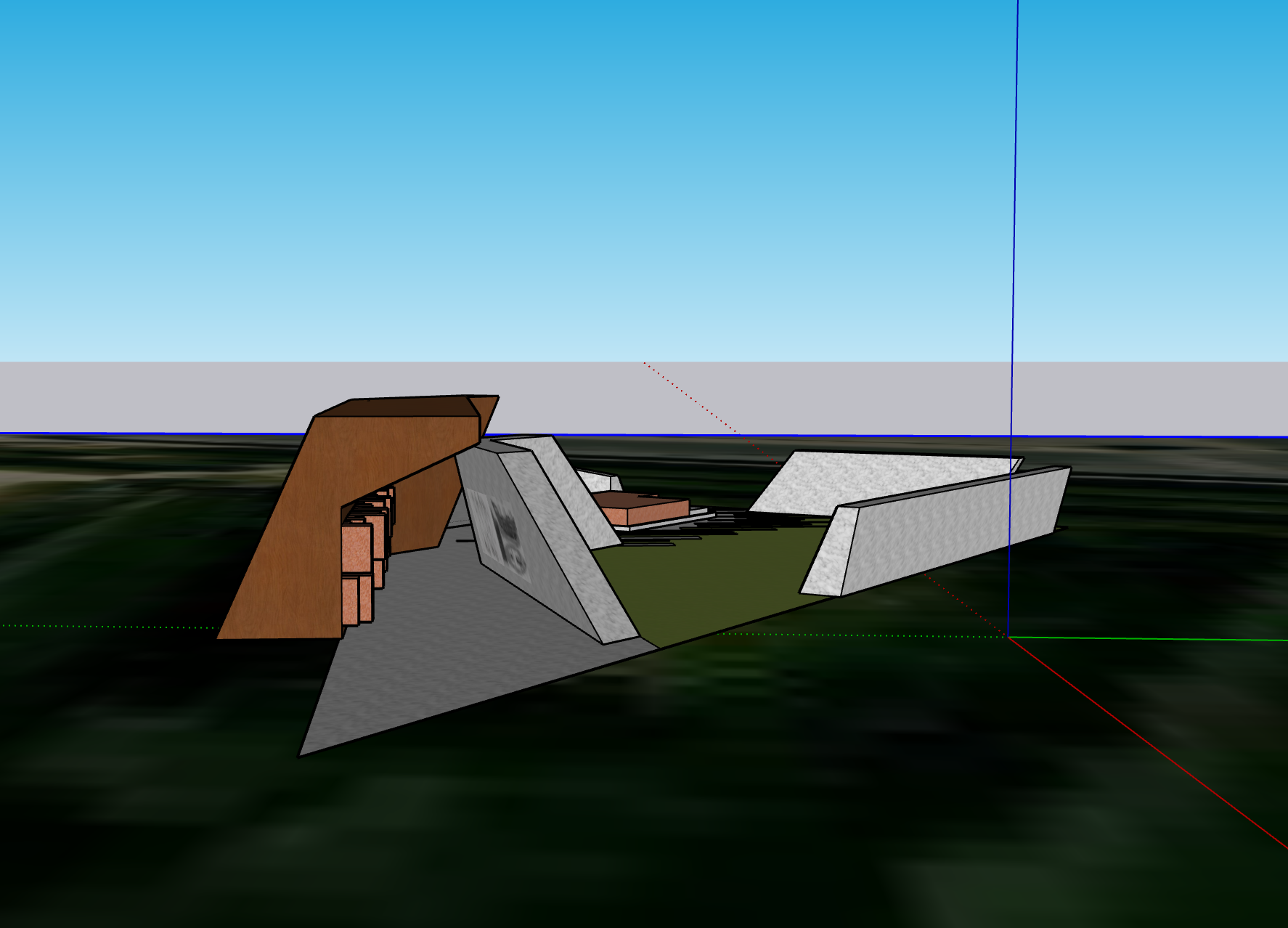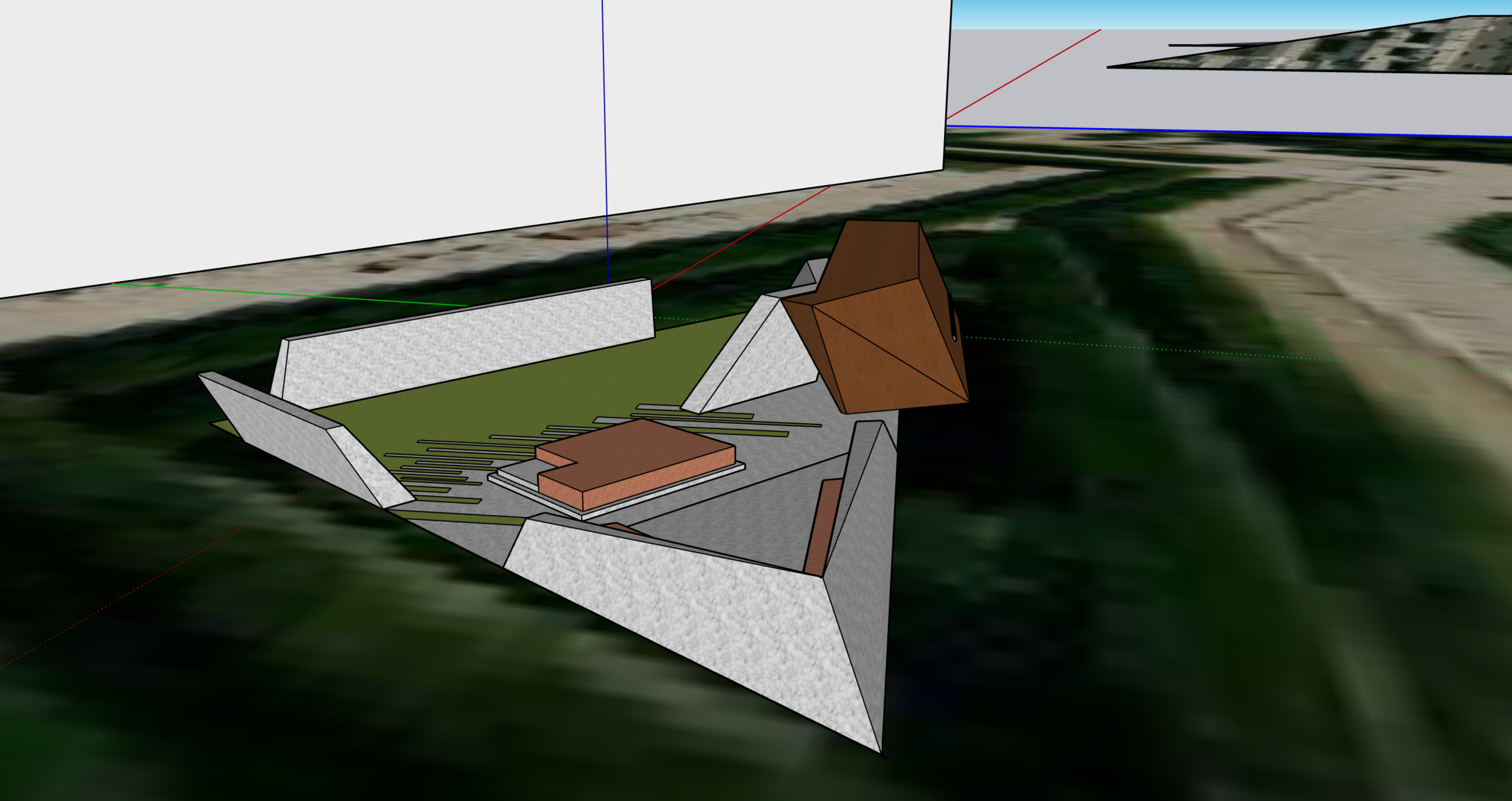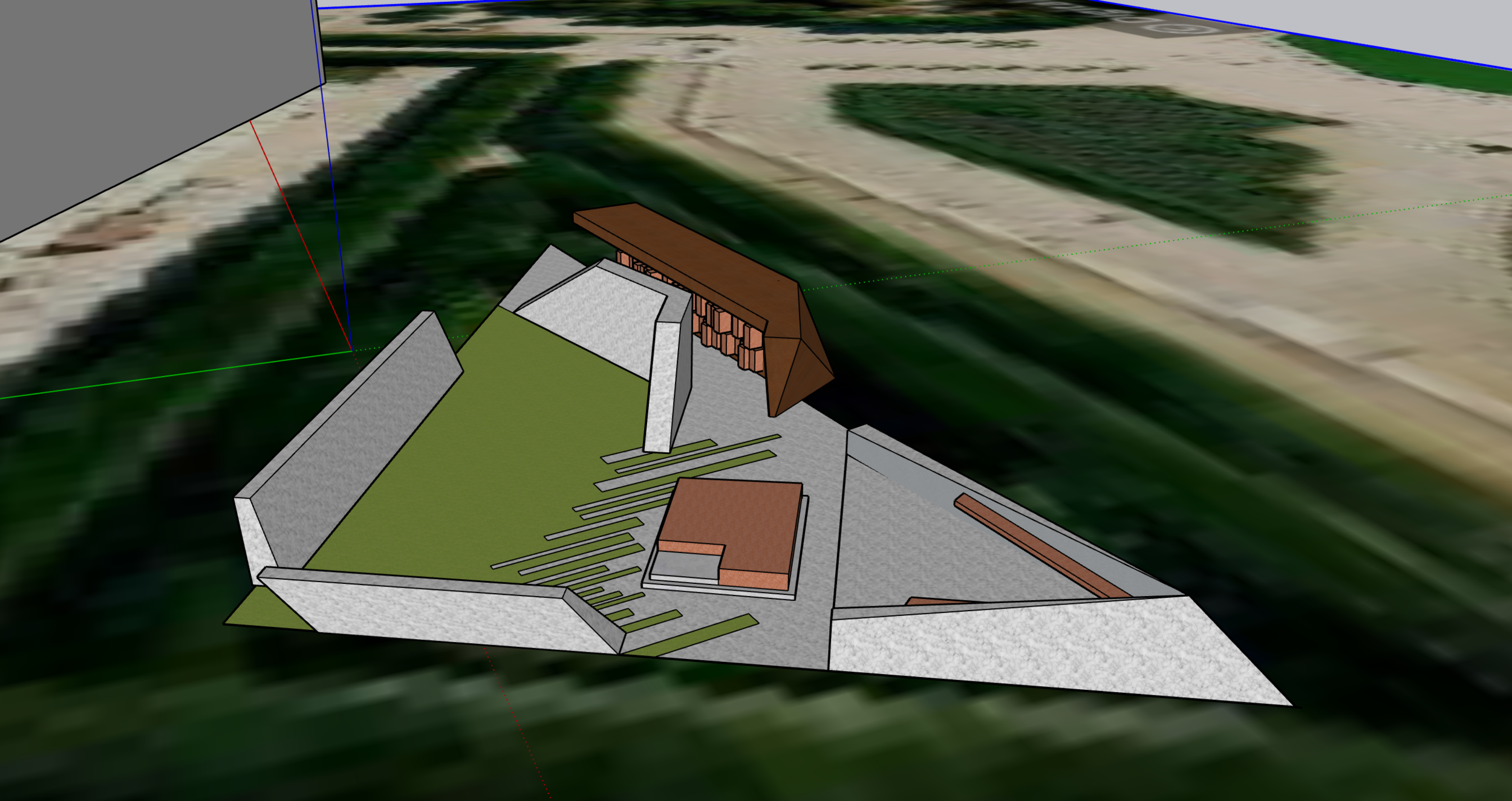Proposal
Response to a Call for artistic application for a Memorial Tribute to the Victims of Slavery at the Tuileries Garden
<Pour lire cette proposition en français, veuillez cliquer ici.>
Figure 1 - Rendu du projet de Mémoire aux Victimes de L'esclavage - Point d'entrée/Rendering of the Memory to the Victims of Slavery project - Entry point. Drawing by Julian Phillips
In June, I learned that there was an open call from the government of France for submissions to design a Memorial to Enslaved People. The French have been having a national conversation about the history of enslavement (in which France was a major player) and the call is part of commitment by the government to recognize and memorialize the nation’s role in enslavement. The seriousness of the endeavor is highlighted by the proposed site for the Memorial-in the Tuilleries Garden outside of the Louvre.
After the circumstances of Boston, I was reluctant to try for another memorial, but this one seemed to have the biggest hurdle addressed-namely, the French people are ready to make a permanent intervention in historic space to talk about the crime and theft of slavery. I would not have to convince people in the government about necessity for the project.
So I got the band back together….
Zoom design meeting with Julian and Patti. Part charente, part therapy, part college preparation, part Master Class in Architecture.
I contacted my team from the Auction Block project (Patti Seitz and Julian Phillips) and when I told them my ideas, they urged me to put together a response to the call. I never would have taken this on without their support, talent, and guidance.
What follows is that proposal. The gorgeous renderings are by Julian Phillips, who took my Sketchup images and breathed life into them.
I know that this is a long shot, but you miss 100% of the shots you don’t take. In any event it was a great project to work on and to realize it up to this point.
CONCEPTION, REALISATION ET INSTALLATION D’UNE OEUVRE D’ART EN HOMMAGE AUX VICTIMES DE L’ESCLAVAGE AU SEIN DU JARDIN DES TUILERIES
Purpose: : Le présent marché a pour objet la conception, la réalisation et l’installation d’une œuvre d’art en hommage aux victimes de l’esclavage au sein du jardin des Tuileries, ainsi que la cession des droits d’auteur liés à cette œuvre.
DESIGN, CONSTRUCTION AND INSTALLATION OF A WORK OF ART IN TRIBUTE TO VICTIMS OF SLAVERY IN THE TUILERIES GARDEN
Purpose:: The purpose of this contract is the design, production and installation of a work of art in tribute to the victims of slavery in the Tuileries Garden, as well as the transfer of related copyright. to this work.
MINISTRY OF CULTURE
General Directorate of artistic creation (DGCA)
182, rue Saint-Honoré 75001 Paris
+33 (0)1 40 15 80 00
Dear Members of the DGCA,
I am an artist who lives and works in the United States. My work dwells at the intersection of race, history, and violence. Because of that, I am drawn to respond to your call for art: CONCEPTION, RÉALISATION ET INSTALLATION D’UNE OEUVRE D’ART EN HOMMAGE AUX VICTIMES DE L’ESCLAVAGE AU SEIN DU JARDIN DES TUILERIES. Architectural plans and drawings are found in Appendix A of this document.
I have done work in the public realm that is outlined in Appendix B. I also have a long exhibition career in museums, galleries, and other spaces that I have outlined in Appendix C.
While I am not a member of a large consortium or an architectural firm, I appreciate the opportunity to share my ideas and my proposal to activate the site in the Tuileries into a space of history, accountability, mourning, and contemplation for the future. I offer the following for your consideration
Person > Object > Citizen
As a descendant of enslaved people, I approach my work as an artist from the point of view of the stolen. I am the result of a great forced diaspora of persons. Persons who survived kidnapping, the Middle Passage, enslavement, sale, labor, rape and death in bondage. Persons stripped of their language and culture in order to reduce them to objects. These objects were then subjected to all manner of coercion and violence. They became objects of toil and commerce for the gain of others. Their stolen lives and labor built and paid for the modern world. Through their resistance and rebellion against oppression they made tangible the enlightenment values of freedom and secured for themselves the blessings and responsibilities of citizenship, helping the nation begin to live up to its creed of liberté, égalité, fraternité.
My proposed work literalizes the forced journey from person to object to citizen that is the hallmark of the slave trade. It makes the history and horrors of enslavement visible and tangible. It places the events and actors involved in the trade in the context of political and economic circumstances. It honors and affirms the lives, labor, and contributions of those lost and stolen, and provides the nation with a site of reflection and remembrance imbued with their presence.
Person
Figure 2 - Jean Boudriot, Untitled Image (Sleeping Positions of Captive Africans on the French Slave Ship L'Aurore), Traite et Navire Nègrier, Collection Archéologie Navale Française (Paris 1984), p. 87. Les Anneaux de la Mèmoire: Nantes-Europe, Afrique, Amèriques (Nantes, France, 1992). Catalog for an exhibition on the slave trade, shown at the Chateau des Ducs de Bretagne, Nantes 1992-1994. (from http://www.slaveryimages.org/s/slaveryimages/item/2552 )
It is imperative to begin with the understanding that slavery was something done to persons. Ships did not leave France for Africa to pick up slaves-they went to capture persons and impress them into servitude. These persons had lives and communities, faith, families, all the same things that their captors had, including the same humanity. This should make it clear that we do not need to confer dignity up on the enslaved, they always had dignity and fought to maintain their humanity despite their inhumane treatment. What we must do is make clear those who acted to remove that dignity and thus committed a crime against a foreign people for the financial benefit of the nation. This removal of dignity is at the heart of the process of enslavement-this removal consists of the political and economic actions taken by a nation-state to reduce a person to the status of an object. This memorial embodies the erasure of persons by capsulizing the experience of openness shattered by a tunnel. The lowest or most stable space on the site symbolizes the person at rest before the disposal of their lives, community, faith, and family.
Object
We have established that “slave” is not an identity and that enslavement is a process that is acted out upon the bodies of persons. This process of objectification involves a series of actions that divorce people from their culture and context. These actions were carried out for financial gain-thus removing their value as persons and replacing it with their value as objects for sale. The dehumanizing treatment of the captured began with their kidnapping and being forced into shackles and packed into the hulls of ships as if they were cattle. Forbidden to communicate with their families, unable to move, being crammed into a space with only about 14x30x60 inches for an entire body they endured the 2 month plus journey of the Middle Passage. Dehydration, poor diet, brutalization by captors, separation from family all played a part in the removal of dignity of the captives. Some demonstrated the only agency they had by jumping overboard, some women doing so with their children in arms.
Once in the colonies, the captives were sold as chattel to slave drivers. The auction block is the literal and metaphorical site of the transformation from person to object. Having no language or understanding of their situation, weakened by a poor diet and the crossing, the dehumanization of the captives was completed by being forced into a context where their lives, labor, and bodies were no longer their own to control. In a completely new world with no community, the captive had to learn to adapt to the situation.
As I said the notion of persons being turned into objects was to satisfy the labor needs of the nation. Over time, the nation advanced narratives that the natural state of the Black person was to be enslaved but they did this to justify their actions-not because there was anything about Black people that made them particularly suited to being treated as objects. The nation used policy, law, and religion to reinforce the idea of Blacks inferiority as a reason why bondage was necessary. Left to their own, Black people would be idle and/or dangerous. These white supremacist ideas lead to the creation of laws and policies to prevent enslaved people from full participation in the country which they now called home.
Citizen
Far from accepting this reduced status, Black people and their abolitionist allies fought in ways large and small to assert their agency as persons. Work stoppages, rebellions, revolutions, and self-advocacy are the hallmarks of enslaved people who demanded the full rights of citizenship that enslavement denied them. Because of their actions, the nation began to see that not only did slavery have to be abolished, but that it was incompatible with the humanist values the Republic professed to want to secure for all of its citizens. Even after the two abolitions-in 1794 and in 1848- the Code Noir and white supremacist attitudes prevented Black people from enjoying all of the elements of citizenship that were taken for granted by their white countrymen.
Over time, the Republic’s Black citizens have made it clear that their contribution to the nation is worthy of honor. The Republic is now willing to admit to stealing the lives and labor of these people and sees the importance of honoring them as citizens who have made the Republic what it is.
Journey: Person > Object > Citizen
Enslavement is fundamentally about the control of the body-the Black body. An obvious response is to re-present that body as a site of veneration, but I think this situation calls for a different form to evoke the presence of all those lost and stolen, rather than relying on an effigy or an idealized representation. As I said before, there is no need to confer dignity on the enslaved because despite their treatment they maintained their humanity. And a traditional figurative gesture runs the risk of being misunderstood over time and distance from our contemporary understandings of the body. Lastly such representations focus on people instead of persons and make enslavement seem a personal act of evil people rather than a political and economic system.
Figure 3 - Rendu du projet de Mémoire aux Victimes de L'esclavage - Vue en plan montrant les trois zones du site / Rendering of the Memory to the Victims of Slavery project - Plan view showing the three thematic areas of the site. Drawing by Julian Phillips.
To address the transformation from person to object, to evoke the body without kitsch or sentiment, to locate the humanity of the enslaved in the monument in a real and tactile way, to engage the viewer with the body and the magnitude of the human cost is my goal. I propose to do this by filling the space of enslavement with the warmth of the lost.
The enslaved captive was restricted below deck for up to 17 hours a day, packed head to toe with others into a space roughly 14x30x60 inches. To evoke this feeling the memorial will have bronze stelae installed into the walls. Each one will measure 14x30 inches to reinscribe the space allotted to each captive. These will project and recede from the wall at varying depths, conferring a sense of individuality onto each unit.
To evoke the presence of the passengers, each stelae will be heated to the temperature of a living body. Thus the rectangular forms will be warm to the touch on a cool day, and will replicate the sensation of placing a hand on a person. The simple rectangular forms will contain the warmth of the humanity of the enslaved without reducing them to caricature. The size makes visible and tangible the political and economic decision to allocate such a small amount of space to a living being-to reduce people to cargo. And by heating each element, the stelae become activated by the viewer’s touch. There is the moment when the metal of the object becomes the flesh of the victim.
These stelae will be set into the wall of a large triangular form that evokes the wooden prow of a ship-the key element of transport of the captives to the colonies for sale. This wall is the dividing line between between person and object. From the outside of the wall, one sees the large wooden surface engraved with the names of all the known slaving vessels that served the Republic. This shows the vastness of the enterprise of enslavement. Turning the corner takes the viewer in to a passage-a direct evocation of the Middle Passage. In one step, you go from person outside in your own context of the Gardens to being swept into the hold of a ship filled with objects-just like the stolen. It is only as one begins to traverse that passage that one discovers the warmth and the presence of the human cargo arrayed on the wall before you.
Figure 4 - Rendu du projet de Mémoire aux Victimes de L'esclavage - Détail du passage du milieu et stèles chauffées / Rendering of the Memory to the Victims of Slavery project - Detail of Middle Passage and heated stelae. Drawing by Julian Phillips.
The passage is framed by the heated stelae on one side and a wall of granite (ideally sourced from Nantes) on the other. These two forms enclose the viewer and provide a shaft of light from above. This is the evocation of being below deck and it also symbolizes the idea of escape and or freedom that was always present in the mind of the enslaved. Carved into the granite wall is the documentation of the slave trade: the names of slaving ports, the names of colonies and the dates of their establishment, the plans for ships, examples of restraints and the colonial maps of the new world. The political and economic decisions on one side with the human presence of the enslaved from the physical shape of the Middle Passage. The passage narrows as the viewer walks, reflecting the loss of language, community, and society.
Upon leaving the Middle Passage, the ship and granite wall give way to a slightly raised platform capped with a piece of black granite in the shape of an auction block. The brutality of being taken resolves itself into a moment where a captive is brought out of the darkness and placed on display for examination and sale-an experience of dehumanization repeated countless times. Long a site of objectification, this sculpture uses that form as a cenotaph and a marker for those who were trafficked and sold. It is accessible to all and provides a moment for mourning and understanding of how the routine display of Black bodies was the direct result of a political and economic system. It will also serve as a meeting point and a speaker’s platform for commemorations and remembrances.
The auction block is bordered by a triangular area that faces the Place de la Concorde and opens to the north toward the Jeu De Paume and the Hotel de la Marine. Facing these sites of national importance to the identity of the Republic and the history of abolition, the viewer encounters that history engraved into the walls of the triangular section. The laws, rebellions, and important dates of resistance are set chronologically into the stone, so that the viewer reads from left to right. Tangible and haptic, the viewer can touch the history as they read and as their body moves through the timeline, they complete the journey to citizenship. The interior wall of the Middle Passage and enslavement has given way to the open air of democracy.
Figure 4 - Rendu du projet de Mémoire aux Victimes de L'esclavage - Vue de la pelouse face au nord-est. Mur de noms (droite et gauche), bloc d'enchères et chronologie de l'historique/View of the lawn facing north-east. Wall of namesl (right and left), Auction Block, and History Timeline
Site plan
Access and Egress
Exploded view with wall heights
Concept drawing for stelae.

























